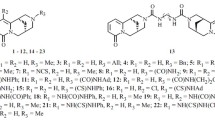Summary
In in vitro short-term (3 h) assays, the β-chloroethyl-methyl-hydrazones B 1 and B 2 inhibit the uptake of 3H-thymidine by EAC and L 1210 leukemia cells, B 2 being 5 to 10 times more effective than B 1. The growth inhibitory effect of both compounds was also confirmed in long-term (7 days) clonal assays using agar-containing glass capillaries, B 2 again being more effective than B 1. In contrast to these differences in vitro, in vivo both substances showed remission to the same degree in EAC- and complete resistance in L 1210-bearing mice. The diverging in vitro/in vivo sensitivities were thought to result from differences in the affinity of the methylhydrazones to the tumor cells: using short exposure periods (3 h) B 1 was more inhibitory than B 2 on both EAC and L 1210 colony growth; i.e., the more hydrophilic B 2 could more easily be washed off. To further test the idea of different cell membrane affinities, the methylhydrazones ZB 1 and P 1 with increasing lipophilic properties were synthesized. In vitro, after both pulse and continuous exposure ZB 1 and P 1 showed enforced inhibitory effects on colony growth. In vivo, ZB 1 and P 1 reduced the tumor weight of EAC mice, while only P 1 increased the survival time of L 1210 mice. The results suggest that from the combination of in vitro/in vivo assays mechanistic conclusions can be derived that are valuable for further development of these cystostatics.
Similar content being viewed by others
Abbreviations
- B 1:
-
N′-methyl-N′-β-chloroethyl-benzaldehyde-hydrazone
- B 2:
-
N′-methyl-N′-β-chloroethyl(p-dimethylamino)benzaldehyde-hydrazone
- EAC:
-
Ehrlich Ascites Carcinoma
- FCS:
-
fetal calf serum
- 3H-dThd:
-
6-3-H-thymidine
- L 1210:
-
Leukemia L 1210
- P 1:
-
N′-methyl-N′-β-chloroethyl-pentadiene-benzaldehyde-hydrazone
- ZB 1:
-
N′-methyl-N′-β-chloroethyl-cinnamoylaldehyde-hydrazone
References
Ali-Osman F, Maurer HR (1980) Comparison of cytostatic sensitivities of L 1210 cells and human stimulated lymphocytes in three cell proliferation assays. J Cancer Clin Oncol 98:221–231
Braun R, Dittmar W (1978) Inhibition of nucleoside uptake into Ehrlich ascites carcinoma cells by new cytostatic methylhydrazones. Cancer Res 38:3512–3517
Braun R, Dittmar W (1980) The influence of cytostatic methyl hydrazones on the intracellular pH and viability of tumor cells. Naturwissenschaften 67:103
Braun R, Dittmar W (1981) On interactions of cytostatic benzylidene hydrazines with SH-groups. Chem Biol Interact 35:229–239
Braun R, Gericke D (1977) Zur antileukämischen Wirkung von N′-Methyl-N′-β-chloroethylhydrazonen. Naturwissenschaften 64:47
Braun R, Hefter E (1977) On structure-activity relationships of N′-methyl-N′-β-chloroethylbenzaldehyde hydrazones. Arzneimittelforsch 27:2114–2117
Braun R, Mangold U, Mangold R (1976) On the cytostatic mechanism of action of N-methyl-N-β-chloroethylhydrazine and its benzaldehydhydrazone. Z Krebsforsch 87:281–299
Braun R, Hefter E, Weber K (1978a) On the action of N′-methyl-N′-β-chloroethylbenzaldehyde hydrazones on aerobic glycolysis of Ehrlich ascites carcinoma cells. Arzneimittelforsch 28:13–16
Braun R, Dittmar W, Gassel WD (1978b) Investigation on the membrane activity of cytostatic methyl hydrazones. Naunyn Schmidebergs Arch Pharmacol Supp Vol 302:R6
Chen HW, Kandutsch AA, Heininger HJ (1980) The role of cholesterol in malignancy. In: Wallach DFH (ed) Membrane anomalies of tumor cells. S Karger, New York, pp 275–316
Dittmar W (1980) Untersuchungen zum Einfluß von zytostatisch aktiven Methylhydrazonen auf die Tumorzellmembran. Thesis, University of Marburg
Grunicke H, Hirsch F, Wolf H, Bauer U, Kiefer G (1975) Selective inhibition of thymidine transport of low doses of the alkylating agent triethylen-imino-benzoquinone (Trenimon). Exp Cell Res 90:357–364
Ihlenfeldt M, Garnter G, Harrer M, Wachter W, Puschendorf B, Grunicke H (1977) The effect of the alkylating antitumor agent triethylenimino-benzoquinone (Trenimon) on membrane functions in Ehrlich ascites tumor cells. Hoppe Seylers Z Physiol Chem 358:1224–1231
Ishida A, Mukaiyame T (1977) A new method for the preparation of 5-alkoxy-α,β-unsaturated aldehydes and polyenals. Bull Chem Soc Jap 50:1161
Isler O, Lindlar H, Montavon M, Rüegg R, Zeller P (1956) Synthesen in der CArotinoid-Reihe. Die technische Synthese von β-Carotin. Helv Chim Acta 39:249
Maurer HR (1981) Potential pitfalls of 3H-thymidine techniques to measure cell proliferation. Cell Tissue Kinet 14:111–120
Volm M, Kaufmann M, Wayss K, Goerttler K, Mattern J (1974) Gezielte Tumor-Chemotherapie durch Onkobiogramm. Dtsch Med Wochenschr 98:38–43
Author information
Authors and Affiliations
Rights and permissions
About this article
Cite this article
Dittmar, W., Klitschka, G., Braun, R. et al. In vitro and in vivo investigations for the development of cytostatic methylhydrazones. J Cancer Res Clin Oncol 110, 110–114 (1985). https://doi.org/10.1007/BF00402721
Received:
Accepted:
Issue Date:
DOI: https://doi.org/10.1007/BF00402721




